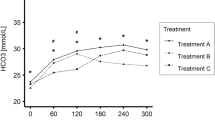Summary
To investigate the pharmacokinetics of TRIS, an infusion of the buffer was given to 6 healthy volunteers (121 mg/kg=1 mmol/kg; pH 7.4) and to 20 patients suffering from metabolic acidosis (109–376 mg/kg; pH 10.9). The drug exhibited two-compartment characteristics in volunteers (t0.5,β=5.6 h) and patients with intact renal function (t0.5,β=16.3–45.6 h). The final volume of distribution (Vβ) indicated uptake into tissues, but equilibration between body compartments was slow. Mainly unchanged TRIS was eliminated by the kidney; 82% of the administered dose was recovered from 24 h-urine of healthy subjects. In the patients a linear correlation between creatinine-clearance and TRIS-clearance was observed, the latter always being somewhat greater than the former. Only insignificant amounts of the drug were found in bile and gastric juice. In anuric patients the plasma concentration of TRIS declined monoexponentially, with a half-life between 10 and 58 h. Haemodialysis or haemofiltration did not influence this process. From the data it seems questionable whether cellular uptake of TRIS is an important factor in the therapy of intracellular acidosis, but the possibility of drug accumulation must be borne in mind if repeated doses are given to the same patient.
Similar content being viewed by others
References
Balagot RC, Tsuji H, Sadoue MS (1961) Use of an osmotic diuretic — THAM — in treatment of barbiturate poisoning. J Am Med Assoc 178: 1000–1004
Bräunlich H (1975) Altersabhängigkeit und Stimulierbarkeit der renalen Ausscheidung von Trishydroxymethylaminomethan (Tham). Arch Int Pharmacodyn Ther 216: 144–159
Brasch H, Iven H (1980) Pharmacokinetics of TRIS in rabbits. Naunyn Schmiedeberg's Arch Pharmacol 313 (Suppl): R 57
Brown ES, Bennet TE, Bunnell IL, Elam JO, Evers JL, Greene DG, Janney CD, Lowe HJ, Nahas GG, Tarail R (1959) Effects of THAM during CO2 breathing in man: ventilation and CO2 exchange. Physiologist 2: 18
Brown ES, Greene DG, Elam JO, Evers JL, Bunnell IL, Lowe HJ (1961) Effects of 2-amino-2-hydroxymethyl-1,3-propanediol on CO2 elimination and production in normal man. Ann NY Acad Sci 92: 508–520
Christensen HN, Clifford J (1962) Test for metabolic attack on Tris (hydroxymethyl) aminomethane and α-hydroxymethyl-serine in the rat. Proc Soc Exp Biol Med (NY) 111: 140–142
Clark LC, jr. (1961) The use of amine buffers in cardiovascular surgery. Ann NY Acad Sci 92: 687–702
Dost FH (1968) Grundlagen der Pharmakokinetik, 2nd ed. Thieme Stuttgart
Epstein RM, Nahas GG, Mark LC (1961) Circulatory changes following rapid correction of severe hypercapnic acidosis by 2-amino-2 hydroxymethyl-1,3-propanediol. Ann NY Acad Sci 92: 500–507
Gibaldi M, Perrier D (1975) Pharmacokinetics. Marcel Dekker, New York
Goetz RH, Selmonosky C, State D (1961) Anuria of hypovolemic shock relieved by tris (hydroxymethyl)aminomethane. Surg Gynecol Obstet 112: 724–728
Goldberg AR, Schwartz I, Verosky M (1962) Equilibrium dialysis of tris (hydroxymethyl)aminomethane (THAM) in serum and albumin. Fed Proc 21: 173
Helwig H (1974) Stoffwechselwirkungen von Trometamol. Anaesthesiol Resuscitat 81: 1–94
Holmdahl MH, Nahas GG (1962) Volume of distribution of C14 labeled tris (hydroxymethyl)aminomethane. Am J Physiol 202: 1011–1014
Hulshoff A, Kostenbauder, HB (1978) Gas chromatographic method for the quantitative determination of tris(hydroxymethyl)aminomethane in plasma. J Chromatogr 145: 155–159
Ligou JC, Nahas GG (1960) Comparative effects of acidosis induced by acid infusion and CO2 accumulation. Am J Physiol 98: 1201–1206
Linn S, Roberts M (1961) Microassay of tris(hydroxymethyl)aminomethane applicable to blood and urine. Ann NY Acad Sci 92: 419–425
Nahas GG (1962) The pharmacology of tris(hydroxymethyl)aminomethane (THAM). Pharmacol Rev 14: 447–472
Nahas GG, Réveillaud RJ, Strauss J, Schwartz I, Verosky M (1963) Renal effects of tris(hydroxymethyl)aminomethane during CO2 load. Am J Physiol 204: 113–118
Robin ED, Wilson RJ, Bromberg PA (1961) Intracellular acid-base relations and intracellular buffers. Ann NY Acad Sci 92: 539–546
Rothe KF, Heisler N (1980) Trometamol: pH dependent tissue distribution. Naunyn Schmiedeberg's Arch Pharmacol 311 (Suppl): R 4
Samiy AH, Oken DE, Rees SB, Robin ED Merrill JP (1961) Effect of 2-amino-2-hydroxymethyl-1,3-propanediol on electrolyte excretion. Ann NY Acad Sci 92: 570–572
Thompson SW, Allen MR, McDowell ME (1965) Toxicity studies with tris(hydroxymethyl)aminomethane. US Army Med Res Nutr Laboratory Rep 285
Author information
Authors and Affiliations
Rights and permissions
About this article
Cite this article
Brasch, H., Thies, E. & Iven, H. Pharmacokinetics of TRIS (hydroxymethyl-)aminomethane in healthy subjects and in patients with metabolic acidosis. Eur J Clin Pharmacol 22, 257–264 (1982). https://doi.org/10.1007/BF00545225
Received:
Revised:
Accepted:
Issue Date:
DOI: https://doi.org/10.1007/BF00545225




